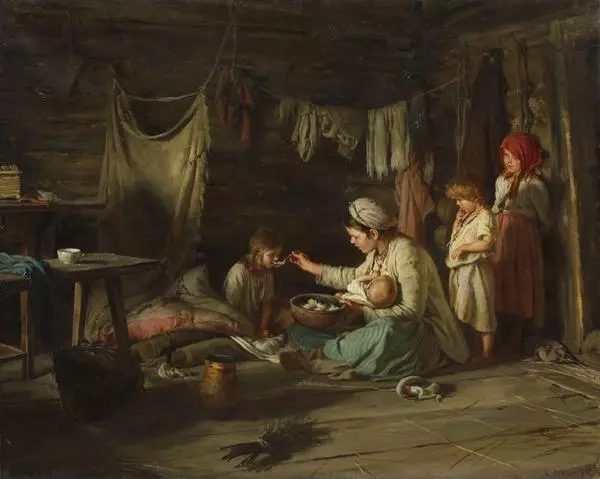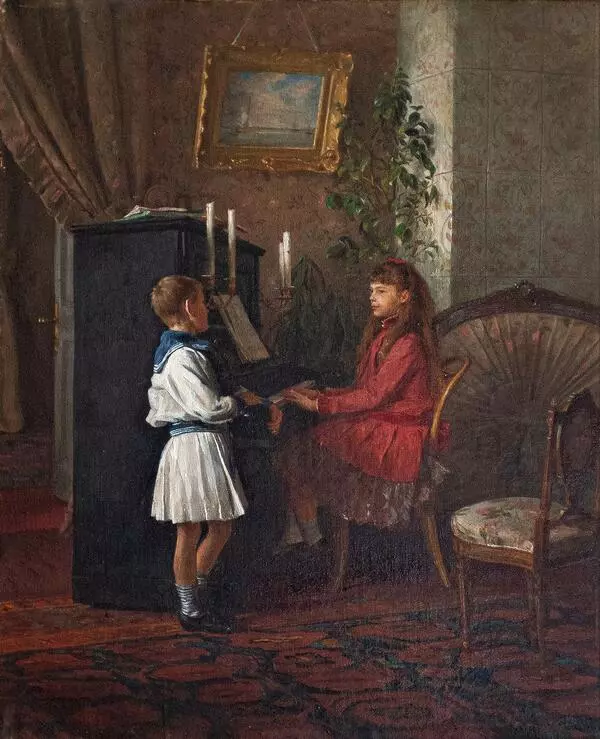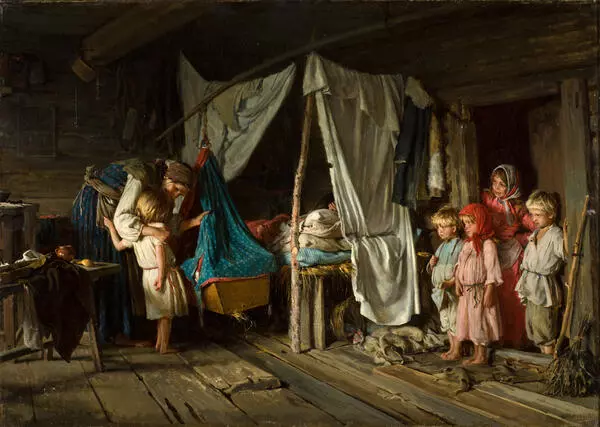Carl Lemoch is a Russian artist who painted genre pictures: country life was the main subject of his art. Lemoch was a member of the Association of Itinerants, he acted as its eternal treasurer, participated in itinerant art exhibitions. He gave private drawing lessons to children from aristocratic families in Saint Petersburg, taught to draw the children of Emperor Alexander III. At the court, he got an Orthodox name – Kirill. The Tsar’s family representatives readily bought Lemoh’s canvases.
The artist purchased a small country house near Moscow. In that country house studio, he created such paintings as Beggar Girl, New Family Member, etc. Local peasants – inhabitants of Khovrino village located not far from the painter’s country house – are depicted on many of his canvases. The artist knew well the villagers, his models would often come to his country house. He painted scenes of peasant life, kept going those in need.
In Khovrino, the painter found one of the important subjects of his art – childhood. He depictured children with special warmth, showing moving scenes from their life, childish joys and sorrows. Canvases depicting children made the artist famous. For the most part, his art was genre, but he also painted portraits. Painting Var’ka appeared for the first time at one of the Itinerants’ exhibitions. Probably, it is the artist’s daughter represented on the canvas as a peasant girl. The painting depicts a pretty boisterous girl: the artist painted her with sincerity and love, precisely conveying the expression on her face observed with sophisticated eye. The master addresses the details giving clue to the child’s character. The girls’ blond hair is covered with a headscarf; she is wearing a simple dress, with beads decoration on her neck. The child has no shoes, peasant children walked barefooted in summer: in the village, children’s shoes were kept for ‘special’ events or for a cold season and were a rarity. The girl is holding a doll in her hands: the doll is, like a young lady, wearing a jacket and a skirt, most probably, this is the girl’s favorite toy. The canvas is filled with a happy and cheerful feeling – this painting became the artist’s great creative achievement.
The artist purchased a small country house near Moscow. In that country house studio, he created such paintings as Beggar Girl, New Family Member, etc. Local peasants – inhabitants of Khovrino village located not far from the painter’s country house – are depicted on many of his canvases. The artist knew well the villagers, his models would often come to his country house. He painted scenes of peasant life, kept going those in need.
In Khovrino, the painter found one of the important subjects of his art – childhood. He depictured children with special warmth, showing moving scenes from their life, childish joys and sorrows. Canvases depicting children made the artist famous. For the most part, his art was genre, but he also painted portraits. Painting Var’ka appeared for the first time at one of the Itinerants’ exhibitions. Probably, it is the artist’s daughter represented on the canvas as a peasant girl. The painting depicts a pretty boisterous girl: the artist painted her with sincerity and love, precisely conveying the expression on her face observed with sophisticated eye. The master addresses the details giving clue to the child’s character. The girls’ blond hair is covered with a headscarf; she is wearing a simple dress, with beads decoration on her neck. The child has no shoes, peasant children walked barefooted in summer: in the village, children’s shoes were kept for ‘special’ events or for a cold season and were a rarity. The girl is holding a doll in her hands: the doll is, like a young lady, wearing a jacket and a skirt, most probably, this is the girl’s favorite toy. The canvas is filled with a happy and cheerful feeling – this painting became the artist’s great creative achievement.







